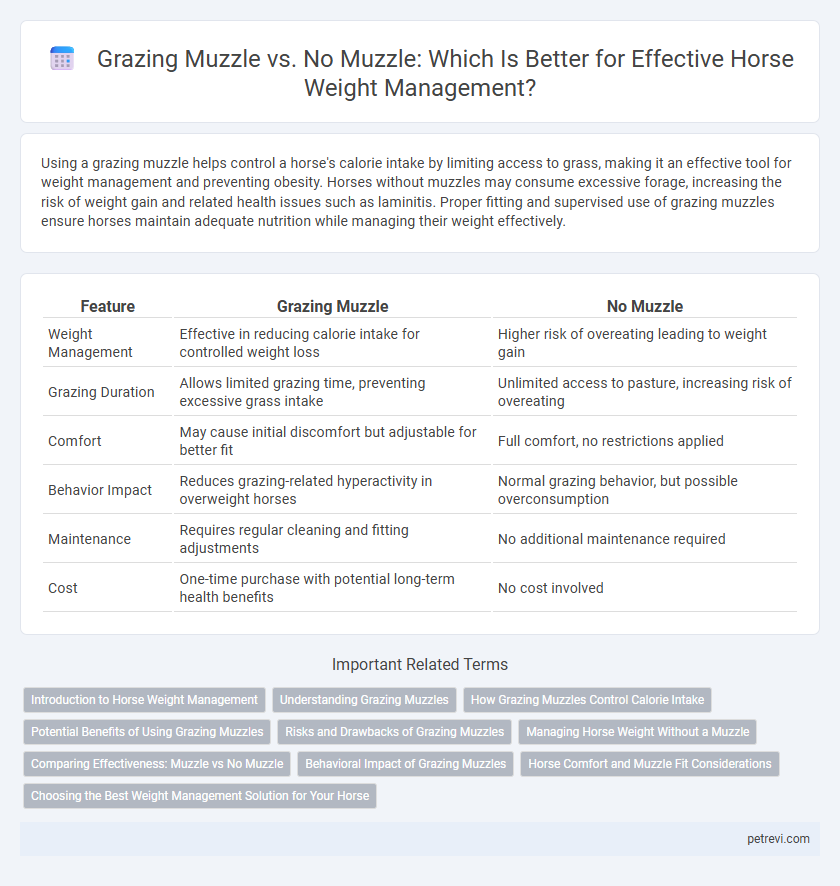Using a grazing muzzle helps control a horse's calorie intake by limiting access to grass, making it an effective tool for weight management and preventing obesity. Horses without muzzles may consume excessive forage, increasing the risk of weight gain and related health issues such as laminitis. Proper fitting and supervised use of grazing muzzles ensure horses maintain adequate nutrition while managing their weight effectively.
Table of Comparison
| Feature | Grazing Muzzle | No Muzzle |
|---|---|---|
| Weight Management | Effective in reducing calorie intake for controlled weight loss | Higher risk of overeating leading to weight gain |
| Grazing Duration | Allows limited grazing time, preventing excessive grass intake | Unlimited access to pasture, increasing risk of overeating |
| Comfort | May cause initial discomfort but adjustable for better fit | Full comfort, no restrictions applied |
| Behavior Impact | Reduces grazing-related hyperactivity in overweight horses | Normal grazing behavior, but possible overconsumption |
| Maintenance | Requires regular cleaning and fitting adjustments | No additional maintenance required |
| Cost | One-time purchase with potential long-term health benefits | No cost involved |
Introduction to Horse Weight Management
Effective horse weight management hinges on controlling calorie intake while maintaining natural grazing behaviors. Grazing muzzles limit forage consumption by reducing mouthfuls without restricting movement, promoting gradual weight loss. Conversely, horses without muzzles may overconsume pasture, increasing risks of obesity and metabolic disorders.
Understanding Grazing Muzzles
Grazing muzzles help control a horse's grass intake by limiting bite size and frequency, which effectively manages weight without restricting water or airflow. Horses without muzzles risk overeating rich pasture, leading to obesity and metabolic issues like laminitis. Choosing the right grazing muzzle requires understanding proper fit and material to ensure comfort and prevent behavioral stress.
How Grazing Muzzles Control Calorie Intake
Grazing muzzles control calorie intake by limiting the horse's ability to consume large quantities of pasture grass, effectively reducing overall energy intake. These devices restrict access to forage without completely preventing eating, helping to prevent excessive weight gain and obesity-related health issues like laminitis. Horses without muzzles have unrestricted grazing, which can lead to overeating and increased risk of metabolic disorders.
Potential Benefits of Using Grazing Muzzles
Grazing muzzles can effectively limit a horse's grass intake, reducing caloric consumption and aiding in weight management by preventing obesity and related metabolic disorders. They allow horses to graze normally while controlling forage intake, promoting healthier weight without causing stress or discomfort. Studies indicate that muzzles help maintain optimal body condition scores and reduce the risk of laminitis in overweight horses.
Risks and Drawbacks of Grazing Muzzles
Grazing muzzles can restrict a horse's natural foraging behavior, potentially causing stress and frustration. Prolonged use may lead to dental wear issues or skin irritation around the muzzle area. Ineffective management risks include horses compensating by eating faster or finding alternative grazing methods, undermining weight control goals.
Managing Horse Weight Without a Muzzle
Managing horse weight without a muzzle involves implementing controlled grazing techniques, such as restricting turnout time or using strip grazing to limit forage intake while maintaining natural feeding behavior. Providing low-calorie, high-fiber feed options and regular exercise programs supports weight management by promoting healthy metabolism and muscle tone. Monitoring body condition scores and adjusting diet based on pasture quality ensures optimal weight control without the stress or discomfort associated with muzzle use.
Comparing Effectiveness: Muzzle vs No Muzzle
Grazing muzzles significantly reduce a horse's forage intake by limiting grass consumption, which directly supports weight management in overweight horses. Horses without muzzles have unrestricted grazing, often leading to excessive calorie intake and potential weight gain, especially on lush pastures. Studies show muzzled horses maintain healthier body conditions by controlling intake without compromising overall forage time.
Behavioral Impact of Grazing Muzzles
Grazing muzzles effectively reduce a horse's grass intake, helping maintain optimal weight while allowing natural foraging behavior. Horses equipped with grazing muzzles often exhibit frustration or increased vocalization initially but typically adapt within days, showing less aggressive or anxious behaviors over time. Removing a muzzle may lead to overeating and weight gain, underscoring its role in balanced nutritional management and behavior regulation.
Horse Comfort and Muzzle Fit Considerations
Grazing muzzles play a crucial role in horse weight management by limiting pasture intake, but comfort and proper fit are essential to prevent stress and skin irritation. A well-fitted muzzle should allow the horse to graze naturally, drink, and breathe easily, promoting acceptance and preventing behavioral issues. Horses without muzzles may overeat, risking obesity and laminitis, but avoiding muzzle-related discomfort requires careful sizing and regular checks to ensure optimal welfare.
Choosing the Best Weight Management Solution for Your Horse
Choosing the best weight management solution for your horse involves assessing grazing muzzle benefits versus no muzzle. Grazing muzzles limit grass intake, effectively reducing calorie consumption while allowing natural foraging behavior, which supports weight control and prevents obesity-related health issues. Horses without muzzles require monitored grazing time and controlled feeding strategies to maintain optimal weight, making individual needs and behavior crucial factors in the decision process.
Grazing Muzzle vs No Muzzle for Horse Weight Management Infographic

 petrevi.com
petrevi.com